In movies, a “Cult Classic” is commonly known as a film that transcends the fleeting measures of box-office success and goes on to realise its full value over time, usually thanks to a small band of loyal supporters. Often, small film companies independently make these kinds of films but occasionally it’s the big Hollywood studios that make a movie which stays in the cultural landscape, even if the initial box office numbers may suggest otherwise.
To use the above analogy, BOSS are the well-known “big studio” of the guitar effects world and have proven time and time again how capable they are of cranking out “Hollywood Blockbuster” pedals. However, over the last 40 years of BOSS compact pedals, there have been more than a few that have elevated themselves to “Cult Classic” level – revered by their fans for their iconic impact, unique tones or sometimes, simply their collectable value!
Let’s take a look at 8 BOSS pedals that are Cult Classics today:
Contributed by Matt Walsham for Roland Corporation Australia
HM-2 Heavy Metal
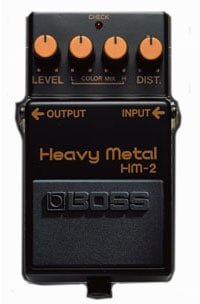 The original intent of the BOSS HM-2 Heavy Metal was to deliver a pedal that could emulate the tone and feel of a roaring Marshall amplifier. BOSS engineers studied the waveforms of Marshall amps on an oscilloscope and developed the HM-2 to replicate the characteristic midrange grind.
The original intent of the BOSS HM-2 Heavy Metal was to deliver a pedal that could emulate the tone and feel of a roaring Marshall amplifier. BOSS engineers studied the waveforms of Marshall amps on an oscilloscope and developed the HM-2 to replicate the characteristic midrange grind.
By their own admission, the HM-2 wasn’t quite the same. It came out like a more compressed version of the Marshall amp sound. Nevertheless, on its release to market in 1983 it sold quite well to legions of guitarists in the “spandex and big hair” era.
The HM-2’s popularity even got a major boost in 1987 when David Gilmour of Pink Floyd used one as part of his studio and live setup for his lead guitar tone during the Momentary Lapse of Reason album and tour.
It wasn’t until the 1991 release of the legendary MT-2 Metal Zone pedal that sales of the HM-2 started to flag. The groundbreaking parametric EQ on the MT-2 was a major technological leap that enabled the Metal Zone to generate a much wider variety of tones than the HM-2 could. Within 7 months of the Metal Zone’s release, production of the HM-2 ceased forever.
Today, the HM-2 is one of the most sought-after BOSS pedals of all time, due to reasons that the designers of the pedal could have never foreseen when they were aiming to create a pedal aimed towards the glam metal market of the day…
A whole subculture of Swedish Death Metal has slowly but surely been growing ever larger since originating in the late 1980’s. Initially an offshoot of mid 1980’s Death Metal (itself an offshoot of Thrash Metal from the early 1980’s), “Swedeath” has reached new popularity peaks and gone on to spawn many other subgenres of super-heavy, guitar based music.
Considered critical to Swedish Death Metal and offshoots of the style is the “buzzsaw sound” – a guitar tone that is exclusively defined by the use of a BOSS HM-2 Heavy Metal pedal, with all knobs turned up full, into an overdriving amp.
Original HM-2 pedal prices are at all-time highs on eBay, and although some small and large manufacturers are building HM-2 clone pedals today, nothing quite carries the street-cred of the original black and orange BOSS box.
Notable HM-2 Users:
Leif “Leffe” Cuzner – Nihilist
Anders “Blakkheim” Nyström and Dan Swanö – Bloodbath
David Blomqvist – Dismember
Alex Hellid and Uffe Cederlund – Entombed
Justin Broadrick – Godflesh
David Gilmour – Pink Floyd
Todd Jones – Nails
EH-2 Enhancer
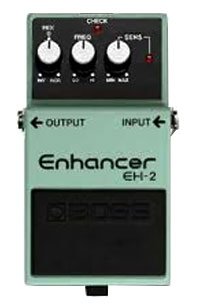 To the uninitiated, the EH-2 sometimes catches players by surprise. It’s a subtle effect that has in the past, fooled some guitarists into thinking it is a “bypass” effect. To others though, the EH-2 is a studio or performance tool like no other.
To the uninitiated, the EH-2 sometimes catches players by surprise. It’s a subtle effect that has in the past, fooled some guitarists into thinking it is a “bypass” effect. To others though, the EH-2 is a studio or performance tool like no other.
The EH-2 is an EQ pedal, mixed with a sort of anti-compressor. It filters off the high frequencies of your guitar tone, and amplifies them (while also generating harmonic overtones). The amount of amplification depends on how hard you play the guitar, i.e. the harder you play, the more the treble frequencies (and overtones) are amplified. In a final neat trick, when you mix these tones in with the original signal (via the MIX knob), you can either select between mixing in a regular polarity signal or a polarity-inverted one. This has the effect of either enhancing or smoothing the top end of your tone – whilst still generating vibrant upper harmonics either way.
As published in “The BOSS Book” (Hal Leonard, 2001) BOSS staff from the period of the EH-2’s release confessed that this “subdued effect” also led to “subdued sales”, despite the fact that the EH-2 was in production for nearly 8 years throughout the 1990’s. It’s “love it or misunderstand it” nature also means that when they can be found on the second hand market, they are reasonably well-priced and don’t reach the lofty heights of such collectables as the VB-2 or HM-2.
Notable EH-2 Users:
Kevin Shields – My Bloody Valentine
Jake E Lee – Ozzy Osbourne/Badlands
DC-2 Dimension C
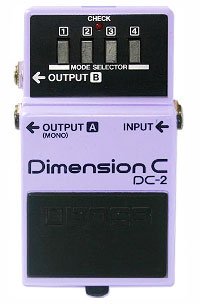 This pedal surely wins the prize as the “weirdest looking” BOSS pedal. Along with a unique pastel lavender paint job, there’s not a single knob to be found anywhere on the DC-2 chassis. In fact, its entire complement of user controls are 4 push buttons which allows the user to select one of the DC-2’s 4 preset sounds. That’s right, presets on a stompbox!
This pedal surely wins the prize as the “weirdest looking” BOSS pedal. Along with a unique pastel lavender paint job, there’s not a single knob to be found anywhere on the DC-2 chassis. In fact, its entire complement of user controls are 4 push buttons which allows the user to select one of the DC-2’s 4 preset sounds. That’s right, presets on a stompbox!
As it turns out, those four preset sounds are pretty fabulous.
The DC-2 pedal was a derivative of the Roland SDD-320 Dimension D rackmount effect. At its heart, the Dimension D contained two independent BBD-driven analog chorus units. These dual choruses were preset to VERY subtle depth rates, but the intermodulation between the independent chorus lines and the clever stereo processing meant that the unit created an incredible feeling of depth or added “dimension”, hence the name. The large 2U rackmount SDD-320 was an instant hit upon its 1979 release and became a recording studio staple, becoming a significant constituent of the stereo “sparkly” sound that was familiar on 1980’s pop radio hits.
In 1985, BOSS thought it would be a great idea to shoehorn the same circuit into a compact pedal chassis, and in doing so created the DC-2 Dimension C. BOSS were already regarded as the masters of chorus – after all they created the first chorus pedal ever (the CE-1 Chorus Ensemble) and had a massive hit with the ubiquitous CE-2 Chorus. The DC-2 Dimension though, was an entirely new flavour that delivered unprecedented levels of spaciousness and texture to guitar tones with its highly refined, ambient sound.
Eventually, the DC-2 fell victim to the “Great Chorus Overuse Syndrome” of the 1980’s and as guitarists began to turn away from highly processed tones to grittier, raw sounds, the DC-2 ran its course and was discontinued from production.
Today, the Dimension C pedal is a highly prized item amongst tone gurus everywhere. Those in the know realise that no pedal produced since can deliver the same airy, floating sound as the DC-2 – which has now confirmed its place in the annals of legendary guitar effects.
Notable DC-2 Users:
Zach Myers – Shinedown
John Petrucci – Dream Theater
Ryan Adams
Phil Keaggy
SG-1 Slow Gear
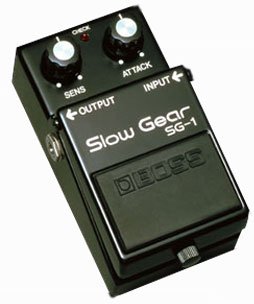 The birth of the SG-1 is an interesting story and plagued with development difficulties. Presumably, in a boardroom decision to incorporate economies of scale, the BOSS designers were tasked to create an effect that used the same circuit that the NF-1 Noise Gate pedal used. From this brief came the idea to completely reverse the operation of a noise gate (which allows the note attack, then clamps down on the tail) and create a unit that muted the attack and swelled the volume of the note tail.
The birth of the SG-1 is an interesting story and plagued with development difficulties. Presumably, in a boardroom decision to incorporate economies of scale, the BOSS designers were tasked to create an effect that used the same circuit that the NF-1 Noise Gate pedal used. From this brief came the idea to completely reverse the operation of a noise gate (which allows the note attack, then clamps down on the tail) and create a unit that muted the attack and swelled the volume of the note tail.
This design concept came from the observation that many Stratocaster players loved to create “violin” swell effects using their guitar’s volume knob. However, the knobs on a Les Paul are positioned much more awkwardly to achieve this same effect. The concept of the SG-1 Slow Gear was to recreate this swell effect, completely automatically.
Tasked with this idea, the BOSS designers got to work – however they swiftly discovered that manipulating the sound envelope to achieve a desirable effect was inordinately difficult. Development dragged on much longer than expected, until eventually a suitable result was reached, and the resulting pedal was christened “Slow Gear”.
Despite the hard work that went into it, the SG-1 was ahead of its time. The user demand wasn’t there and production of the pedal ceased within 3 years of its introduction.
Today, the SG-1 is considered one of the most desirable vintage BOSS pedals to own and fetches premium prices on the used market. Partly because 35 years later it’s still a completely unique effect and partly for the pure rarity/collectable factor, it is the very definition of a cult classic pedal!
Notable SG-1 Users:
Josh Klinghoffer – RHCP
CE-2 Chorus
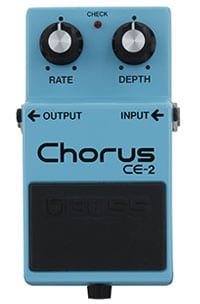 BOSS has always been particularly proud of its line of chorus pedals, not just because they are huge sellers, but because they literally invented the chorus pedal. When the BOSS division of Roland first emerged in 1976, they repurposed the chorus effect from Roland’s famous JC-120 amplifier and made it available in a (gigantic) AC powered foot pedal, named the CE-1 Chorus Ensemble. Though the CE-1 had a slow start, it soon became a huge hit thanks to use by Herbie Hancock and Andy Summers of The Police amongst others and was largely responsible for getting the BOSS brand off the ground.
BOSS has always been particularly proud of its line of chorus pedals, not just because they are huge sellers, but because they literally invented the chorus pedal. When the BOSS division of Roland first emerged in 1976, they repurposed the chorus effect from Roland’s famous JC-120 amplifier and made it available in a (gigantic) AC powered foot pedal, named the CE-1 Chorus Ensemble. Though the CE-1 had a slow start, it soon became a huge hit thanks to use by Herbie Hancock and Andy Summers of The Police amongst others and was largely responsible for getting the BOSS brand off the ground.
So successful had the CE-1 been, that when BOSS changed the world by releasing their now legendary line of compact pedals in 1977, there was huge pressure to transfer the tone of the CE-1 into a compact chassis. This was no small task and the BOSS engineers took two years to be able to achieve this engineering feat, but the result was worth it. In October 1979, the CE-2 Chorus pedal was released and still stands today as perhaps the most famous chorus pedal ever and a benchmark by which all other chorus pedals are judged.
The BBD-powered analog heart of the CE-2 was very similar indeed to the CE-1 circuit, though the CE-2 emerged with a slightly different voice to its predecessor, thanks in large part to its higher input impedance. The CE-2 Chorus adds all the depth and sparkle that are BOSS Chorus hallmarks, but also adds a fat, thick midrange boost when engaged that turned out to be a famous and sought after characteristic of the CE-2’s tone.
As a flagship product, BOSS continued to place high importance on developing its chorus pedals and despite its huge success, the CE-2 ceased production in 1982 just three short years after its introduction to make way for its successor – the CE-3 Chorus.
Today, the BOSS chorus line has diverged into two best-selling products – the CE-5 Chorus Ensemble and the CH-1 Super Chorus. For many players however, (including some of the biggest names in the guitar world), the CE-2 continues to be their go-to chorus pedal and one of the most loved BOSS pedals of all time.
Notable CE-2 Users:
David Gilmour – Pink Floyd
Gary Moore
Johnny Winter
Joe Bonamassa
Kim Thayil – Soundgarden
Brian Setzer
John Schofield
Johnny Marr – The Smiths
SP-1 Spectrum
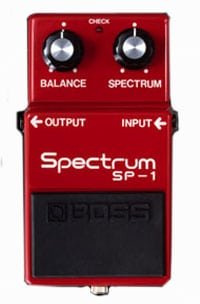 The now-ubiquitous BOSS compact pedal design first appeared in 1977. The first 3 pedals to roll off the line were the PH-1 Phaser, the OD-1 Overdrive and the SP-1 Spectrum.
The now-ubiquitous BOSS compact pedal design first appeared in 1977. The first 3 pedals to roll off the line were the PH-1 Phaser, the OD-1 Overdrive and the SP-1 Spectrum.
Sometimes dubbed the “traffic light” pedals due to their Red/Yellow/Green colouring, all 3 of those groundbreaking pedals will forever be remembered historically…..but there is a special space reserved for the SP-1 Spectrum.
The SP-1 is essentially a single band, fixed gain, fixed Q, parametric EQ boost. The SPECTRUM control allows you to select the boosted frequency between 500Hz – 5kHz, and the BALANCE control balances the Wet/Dry signal mix.
It is certainly a unique effect pedal. Although some users found great use in its ability to sound like a cocked wah-wah or its ability to allow an instrument to pierce through a dense mix, most musicians were somewhat perplexed by the SP-1. Sales were slow and the SP-1 was discontinued from production in 1981. Keyboard and electric piano players however, did hold it in high esteem during its initial run.
Jump forward to 2016 and the SP-1 is known as being the most valuable of all regular production BOSS pedals, thanks to its incredible rarity, and the rise of the modern day hobby of BOSS pedal collecting. No self-respecting BOSS junkie can claim their pedal collection is complete without an SP-1 Spectrum on hand. This fact has driven second hand prices into the stratosphere, as rabid collectors enter into bidding wars over this most elusive of pedals.
Whether obtained for its unique tonal signature or its collectable value, the SP-1 has surely become one of the most memorable and classic BOSS pedals ever.
Notable SP-1 Users:
Billy Corgan – Smashing Pumpkins
DD-2 Digital Delay
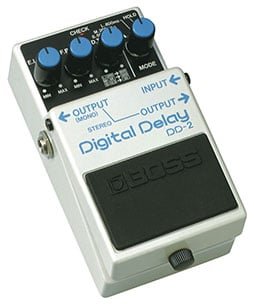 The DD-2 pedal is perhaps one of the most interesting of all BOSS pedal stories.
The DD-2 pedal is perhaps one of the most interesting of all BOSS pedal stories.
In 1983, pro-touring guitar players were embracing the reasonably new technology of Digital Delay units – which produced pristine, clear echo tones which were in stark contrast to the gritty analog delay tones that had been the norm until then.
The problem was that Digital Delay units were large (only available in rackmount format) and somewhat expensive – putting them out of reach of the amateur or even semi-pro player.
BOSS dropped a bombshell on an unsuspecting musical world by releasing the DD-2. A digital delay within a compact pedal format was simply beyond belief. Indeed, it hadn’t been an easy feat. The custom IC chip (the same as found in the legendary SDE-3000 rack delay) could only just fit within the compact chassis, and the engineering team had an immense struggle trying to fit in all the rest of the supporting circuitry. The fact that they managed to do so was an engineering marvel, and after the public had picked their jaws up from the floor, they started buying the DD-2 in huge numbers, despite its substantial price tag.
Just 3 years later, thanks to the technological boom of the 1980’s, the price of digital RAM technology was dropping exponentially. BOSS passed on these savings to the customer by dropping the price of the DD-2, however as the RAM prices kept falling further, an interesting decision was made.
BOSS decided that continually dropping the price of a pedal was a bad look for the company. So instead, BOSS released a “new” model of lower-priced Digital Delay pedal called the DD-3. In actual fact, the DD-3 was exactly the same pedal as the DD-2 – just with some new silk-screen printing and a lower price tag.
Such has been the legacy of the world-changing BOSS Digital Delay pedal that the DD-3 is still in production today. Although it has seen a couple of design revisions over the years due to component availability, today’s DD-3 pedal is still essentially the same design as the DD-2 pedal that first blew minds back in 1983. Collectors of course, still clamour to get their hands on a DD-2 for the sake of history, and indeed it is the pedal’s place in history that defines the DD-2 as a cult classic.
Notable DD-2 Users:
David Gilmour – Pink Floyd
Carlos Santana
Joe Satriani
Tony Levin
PN-2 Tremolo / Pan
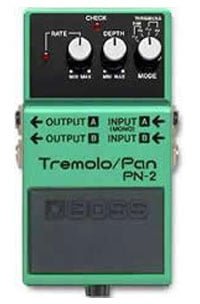 As the song goes….”You don’t know what you’ve got till it’s gone”.
As the song goes….”You don’t know what you’ve got till it’s gone”.
The PN-2 was essentially a simple tremolo pedal that offered the user the option to connect two amplifiers and have the tremolo effect pan between the two amps in stereo, creating a very wide soundstage.
In what most acknowledge as a case of simple bad timing, the PN-2 was released in 1990, a time when guitar players were focussed on heavy distortion, digital delays, speedy licks and permed hair. Tremolo was seen as an antiquated 1960’s effect and the PN-2 didn’t find much favour.
Over the next few years, Grunge music arrived and dominated – its punk aesthetic again not finding much use for Tremolo effects, and the PN-2 quietly disappeared from production in 1995.
At more or less precisely the same time, a new wave of Britpop started taking the world by storm, bringing with it a disdain for cutting edge technology. So began the revival of vintage guitars, amplifiers….and effects. Tremolo suddenly became desirable and soon enough, requests were flooding into BOSS for a tremolo pedal – resulting in the 1997 release of the TR-2 Tremolo pedal that still continues today.
The TR-2 is a best seller now, and something of an industry standard. For those in the elite club of gigging with 2 amps though, the monaural TR-2 doesn’t scratch the itch in quite the same way as the PN-2 Tremolo/Pan – assuring that the latter holds its place as a cult classic for some time yet to come.
Notable PN-2 Users:
Juan Alderete (The Mars Volta)
Kevin Shields (My Bloody Valentine)
Jon Spencer Blues Explosion
Bernard Butler (Suede)
Related Articles
BOSS PEDALS OF THE PROS
ECHOES IN TIME: THE HISTORY OF BOSS DELAY PEDALS




